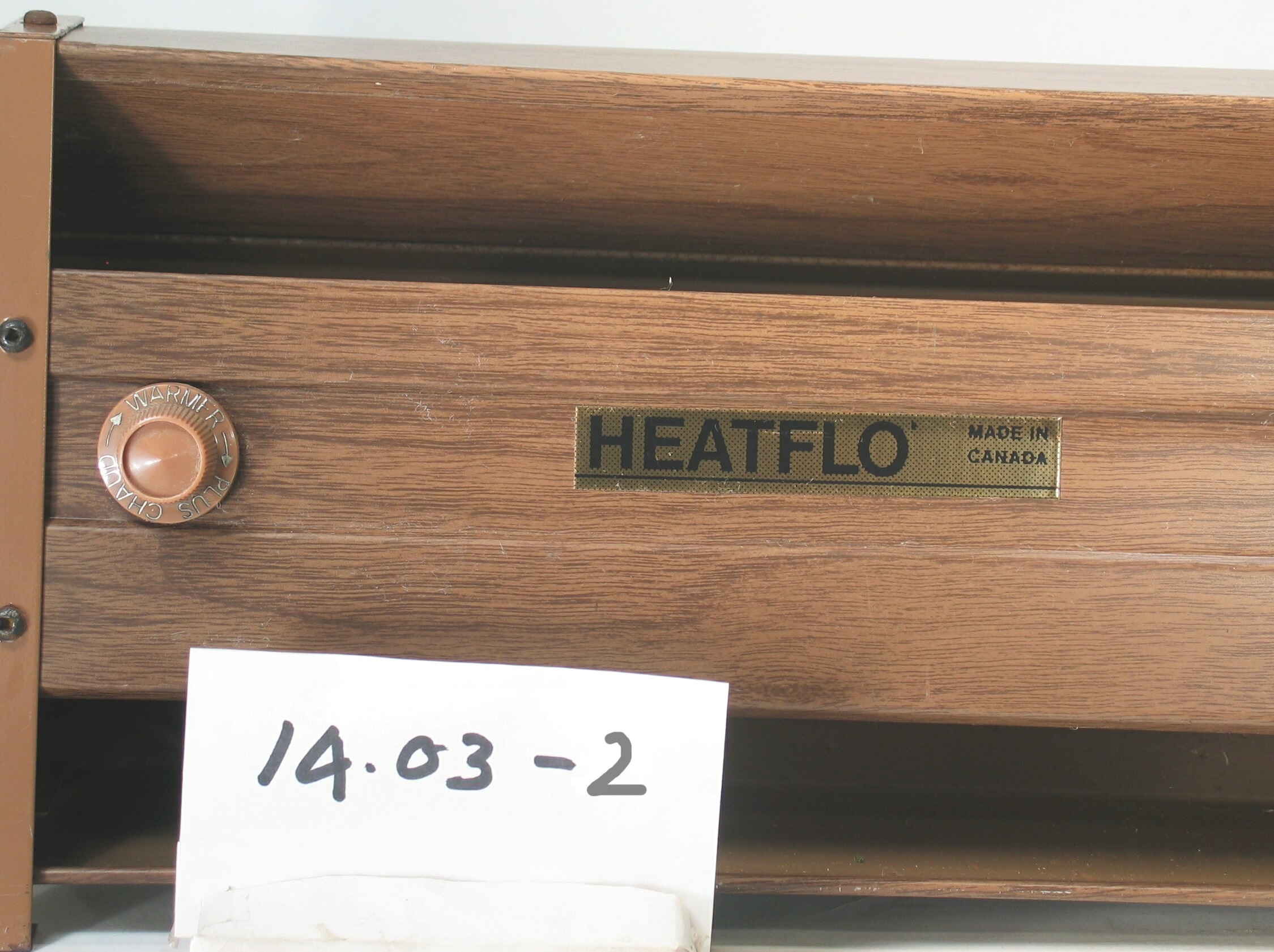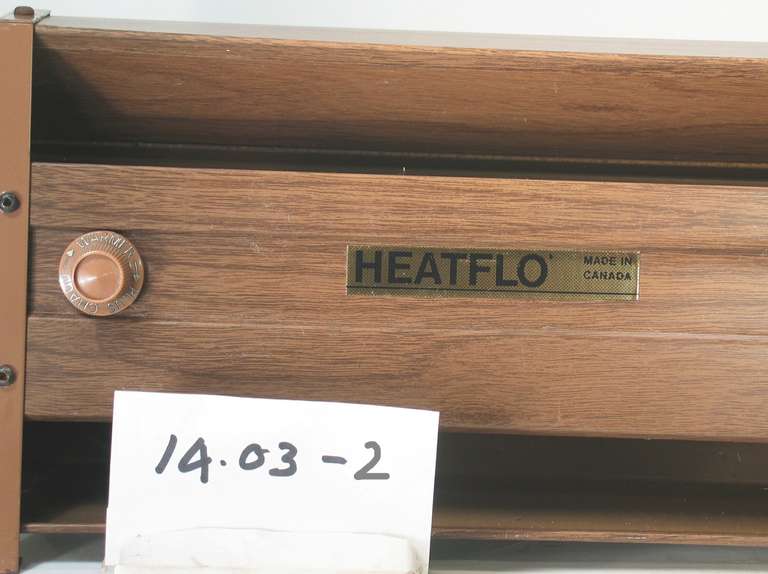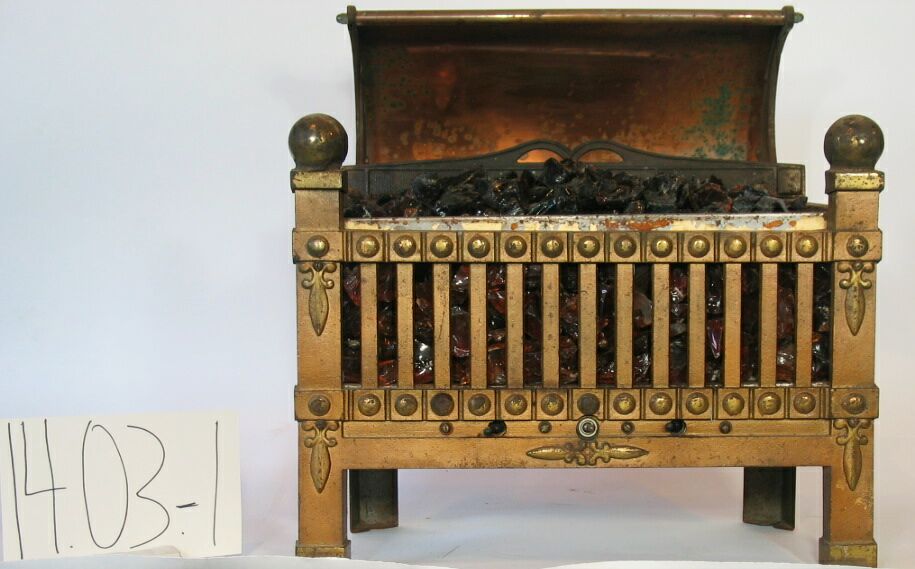14.03-2: Heatflo 1960 Electric Baseboard Style Room Heater

| HHCC Accession No. 2006.100 | HHCC Classification Code: 14.03-2 |
|---|
Description:
An electric baseboard style room heater, a marker of what would prove to be a relatively short blip in time when electrical energy in much of Canada was perceived as plentiful and highly promoted for residential space heating. Here shown in a 42 inch unit with simulated walnut metallic finish, built in thermostat and line cord, 1200 w, 120 volts; HeatFlo, Canada, Cat PB414, circa 1960 [See also ID # 221]
Group:
14.03 Electric Heating Equipment - Space Heating
Make:
Heatflo
Manufacturer:
Heatflo, Canada
Model:
Cat. PB414
Serial No.:
Size:
42 x 4 x x 7 ‘h
Weight:
3 lbs.
Circa:
1960
Rating:
Exhibit, education, and research quality, illustrating the styling and engineering design of mid 20th century electric baseboard heating unit for Canadian homes, part of the electric space heating equipment highly marked by many Canadian electric utilities for residential use in the period when electrical energy was seen as plentiful in an ever expanding marketplace.
Patent Date/Number:
Provenance:
From York County (York Region) Ontario, once a rich agricultural hinterlands, attracting early settlement in the last years of the 18th century. Located on the north slopes of the Oak Ridges Moraine, within 20 miles of Toronto, the County would also attract early ex-urban development, to be come a wealthy market place for the emerging household and consumer technologies of the early and mid 20th century.
This artifact was discovered in the 1950’s in the used stock of T. H. Oliver, Refrigeration and Electric Sales and Service, Aurora, Ontario, an early worker in the field of agricultural, industrial and consumer technology.
Type and Design:
Fin and tube heater element Low rise baseboard design Brake-formed metal cabinet Self taping sheet metal screw assembly Simulated walnut metallic finish Built in adjustable thermostat 8 foot line cord, twin conductor rubber covered
Construction:
Material:
Special Features:
Company name on black on gold background, on inexpensive adhesive label
Accessories:
Capacities:
120 volts 1200 watts
Performance Characteristics:
Operation:
Control and Regulation:
Targeted Market Segment:
Consumer Acceptance:
Merchandising:
Market Price:
Technological Significance:
The significance of this artifact is two fold: First, as a representative of the class of portable room heaters that emerged in the late 1950’s and 1960’s, piggy backing on the popularity of central system, electric, resitance, base-board home heating. It would be a trend relatively short lived, as other forms of portable electric space heaters came along more convenient, compact, safer and with more inherent market appeal. Second, as a representative of the form and construction of the baseboard units used as components in central systems of the times.
Industrial Significance:
As in any new, rapidly expanding field of engineering and production of consumer goods many new players are attracted to the field. Many hope to turn a quick profit under the market conditions of the moment, with a minimum investment, but often without the staying power needed for long term growth and participation in the field. ‘Heatflo’ appears to have been of that nature, using very conventional low-tech cabinet manufacturing and assembly techniques, possibly purchasing their electric heaters from another major supplier of the period.
Socio-economic Significance:
From the vantage point of the early 21st century, it is difficult to understand the euphoria and naivety with which electric, resitance, base-board heating was celebrated in the 1960’s through 80’s, in areas of Canada where the electric utilities would promote its use. Resistance electric baseboard heating of the era would be a marker of that relatively brief period in the middle years of the 20th century, following W.W.II., in which there was great expectations for the future development of electrical utilities and the attendant need to build markets to support the economic costs of the development of requisite new generating capacity. It was a period when automatic electrical heating was successfully being promoted as: 100% efficient on an energy conversion basis, clean heat, free of mechanical equipment and encumbrances and attendant worries for the householder, no matter the fact that on a cost per BTU, electric resistance base-board heating was several times that of oil and gas fired heating systems. Those who saw themselves as community leaders and pacesetters in the way they embraced the latest technology and could afford to be so, were anxious to demonstrate the new world of automatic home heating that had arrived. The realities, social and economic costs and limits, on the development of electrical generation capacity would shortly follow, as the possibilities for vast hydro generation projects, once anticipated, diminished and as experience with both thermal and nuclear generation accumulated. A comprehensive training manual [sales, engineering, installation and service] produced by the Sales Promotion Division of Ontario Hydro in 1960 would tell the stories of the euphoria of the times. Making extensive use of hyperbola, it would paint an unusually rosy picture of the advantages to consumers of electric home heating, seemingly with little understanding of the events which would shortly reshape the life of electric utilities in Canada and throughout North America [See Reference].
Socio-cultural Significance:
Donor:
G. Leslie Oliver, The T. H. Oliver HVACR Collection
HHCC Storage Location:
Tracking:
Bibliographic References:
Training Manual, the sales Promotion Division, Ontario Hydro, 600 University Ave. Toronto, November 1960 [Oliver Collection]


